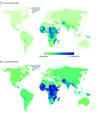Modeled Carbon Footprint of Change of Sterile Gloves and Instruments for Abdominal Wound Closure
- PMID: 40768147
- PMCID: PMC12329605
- DOI: 10.1001/jamanetworkopen.2025.25355
Modeled Carbon Footprint of Change of Sterile Gloves and Instruments for Abdominal Wound Closure
Abstract
Importance: The Cheetah randomized trial demonstrated that changing sterile gloves and instruments before wound closure reduces surgical site infections (SSI) in abdominal surgery. However, its environmental impact remains unclear.
Objectives: To estimate the global carbon footprint associated with changing sterile gloves and instruments before closure abdominal wound.
Design, setting, and participants: This decision analytic model compared the carbon footprint of a glove and instrument change intervention against a control (no glove and instrument change). Model parameters were sourced from a large cluster randomized trial conducted in 7 low- and middle-income countries (LMICs) between June 2020 and March 2022, as well as data from stakeholder engagement and existing research. Boundaries included the trial intervention and in-hospital resources used to manage SSI. The analysis was stratified by wound contamination status (clean-contaminated, contaminated-dirty) and country-income classification.
Main outcome and measures: Average per-patient wound-specific carbon footprint, calculated as the sum of the carbon footprint of glove and instrument change and SSI. Sensitivity analyses were based on the lowest and highest possible values for key model parameters: intervention effectiveness, intervention carbon footprint, and SSI carbon footprint. The best-case analysis was based on highest possible intervention effectiveness, lowest possible intervention carbon footprint, highest possible SSI carbon footprint. The worst-case analysis was based on lowest intervention effectiveness, highest intervention carbon footprint, and lowest SSI carbon footprint.
Results: In LMICs, the difference in carbon footprints between the intervention and control groups was 10.97 kg CO2 equivalents (kgCO2e) (scenario range, -2.53 to 33.50 kgCO2e) for clean-contaminated and 22.60 kgCO2e (scenario range, -1.62 to 61.17 kgCO2e) for contaminated-dirty surgeries. In high-income countries, differences were 4.14 kgCO2e (scenario range, -3.38 to 17.95 kgCO2e) and 10.48 kgCO2e (scenario range, -3.06 to 37.62 kgCO2e), respectively. Country-level modeling found the intervention to be consistently associated with a lower wound-specific carbon footprint across all countries.
Conclusions and relevance: In this decision analytic model, sterile glove and instrument change before wound closure was associated with a reduced wound-specific carbon footprint across all country income settings. Alongside clinical and economic benefits, this intervention may support more sustainable surgical care; national associations and governments should consider its adoption to improve outcomes for both patients and the planet.
Conflict of interest statement
Figures


References
-
- Bhangu A, Frankling C, Glasbey J, et al. Net zero surgery: proof of concept and uncertainties. Bull Royal Coll Surg England. 2022;104(7). doi: 10.1308/rcsbull.2022.129 - DOI
MeSH terms
LinkOut - more resources
Full Text Sources

